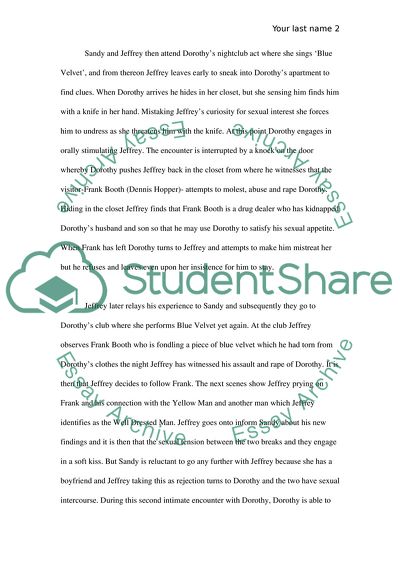Cite this document
(Interpretations of David Lynch's film Blue Velvet Movie Review - 1, n.d.)
Interpretations of David Lynch's film Blue Velvet Movie Review - 1. https://studentshare.org/visual-arts-film-studies/1785210-interpretations-of-david-lynchs-film-blue-velvet-1986-often-suggest-that-the-film-either-cultivates-the-sincere-and-innocent-sensibility-of-the-1950s-or-that-it-savagely-deconstructs-those-formulas-through-the-use-of-irony-cont
Interpretations of David Lynch's film Blue Velvet Movie Review - 1. https://studentshare.org/visual-arts-film-studies/1785210-interpretations-of-david-lynchs-film-blue-velvet-1986-often-suggest-that-the-film-either-cultivates-the-sincere-and-innocent-sensibility-of-the-1950s-or-that-it-savagely-deconstructs-those-formulas-through-the-use-of-irony-cont
(Interpretations of David Lynch'S Film Blue Velvet Movie Review - 1)
Interpretations of David Lynch'S Film Blue Velvet Movie Review - 1. https://studentshare.org/visual-arts-film-studies/1785210-interpretations-of-david-lynchs-film-blue-velvet-1986-often-suggest-that-the-film-either-cultivates-the-sincere-and-innocent-sensibility-of-the-1950s-or-that-it-savagely-deconstructs-those-formulas-through-the-use-of-irony-cont.
Interpretations of David Lynch'S Film Blue Velvet Movie Review - 1. https://studentshare.org/visual-arts-film-studies/1785210-interpretations-of-david-lynchs-film-blue-velvet-1986-often-suggest-that-the-film-either-cultivates-the-sincere-and-innocent-sensibility-of-the-1950s-or-that-it-savagely-deconstructs-those-formulas-through-the-use-of-irony-cont.
“Interpretations of David Lynch'S Film Blue Velvet Movie Review - 1”. https://studentshare.org/visual-arts-film-studies/1785210-interpretations-of-david-lynchs-film-blue-velvet-1986-often-suggest-that-the-film-either-cultivates-the-sincere-and-innocent-sensibility-of-the-1950s-or-that-it-savagely-deconstructs-those-formulas-through-the-use-of-irony-cont.


